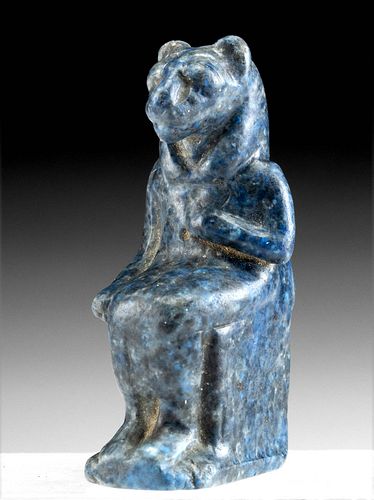Rare Egyptian Lapis Lazuli Seated Sekhmet Amulet
Lot 15
About Seller
Artemis Fine Arts
686 S Taylor Ave, Ste 106
Louisville, CO 80027
United States
Selling antiquities, ancient and ethnographic art online since 1993, Artemis Gallery specializes in Classical Antiquities (Egyptian, Greek, Roman, Near Eastern), Asian, Pre-Columbian, African / Tribal / Oceanographic art. Our extensive inventory includes pottery, stone, metal, wood, glass and textil...Read more
Estimate:
$7,000 - $10,000
Absentee vs Live bid
Two ways to bid:
- Leave a max absentee bid and the platform will bid on your behalf up to your maximum bid during the live auction.
- Bid live during the auction and your bids will be submitted real-time to the auctioneer.
Bid Increments
| Price | Bid Increment |
|---|---|
| $0 | $25 |
| $300 | $50 |
| $1,000 | $100 |
| $2,000 | $250 |
| $5,000 | $500 |
| $10,000 | $1,000 |
| $20,000 | $2,500 |
| $50,000 | $5,000 |
| $100,000 | $10,000 |
| $200,000 | $20,000 |
About Auction
By Artemis Fine Arts
Mar 24, 2022
Set Reminder
2022-03-24 10:00:00
2022-03-24 10:00:00
America/New_York
Bidsquare
Bidsquare : Exceptional Antiquities Ethnographic Fine Art
https://www.bidsquare.com/auctions/artemis-gallery/exceptional-antiquities-ethnographic-fine-art-9057
Museum-worthy examples of classical antiquities (Egyptian, Greek, Roman, Near Eastern), Viking, Far East / Asian, Pre-Columbian, African / Tribal, Oceanic, Native American, Spanish Colonial, Fossils, Ancient Jewelry, Fine / Visual Arts, so much more! Artemis Fine Arts info@artemisgallery.com
Museum-worthy examples of classical antiquities (Egyptian, Greek, Roman, Near Eastern), Viking, Far East / Asian, Pre-Columbian, African / Tribal, Oceanic, Native American, Spanish Colonial, Fossils, Ancient Jewelry, Fine / Visual Arts, so much more! Artemis Fine Arts info@artemisgallery.com
- Lot Description
Egypt, Late Dynastic Period, 26th to 31st Dynasty, ca. 664 to 332 BCE. A lovely and petite amulet depicting Sekhmet, the lioness-headed goddess of war, military strategy, and healing. Hand-carved from mottled cobalt blue lapis lazuli with burnt ochre, khaki, and dark brown inclusions, the leonine deity presents in a seated pose atop an integral plinth while holding one arm to her bosom and the other against her side. Each lateral side of the throne bears an incised image of 2 Was scepters and an ankh which suggest power, dominion, and control over life. She wears an ankle-length skirt beneath a headdress with lengthy lappets, and an integral suspension loop is situated behind her head. Her protruding countenance exhibits a pair of miniscule eyes beneath thick brows, a narrow snout with delineated jowls, and a narrow nose, all beneath a pair of tab-shaped ears that flank a central cavity meant for attaching a separate headdress like a sun disc. Size: 0.9" L x 0.56" W x 1.37" H (2.3 cm x 1.4 cm x 3.5 cm)
Sekhmet (also Sakhmet), among the oldest deities in the Egyptian pantheon, is typically depicted as a lion-headed woman and sometimes wearing a sun disc on her head. When shown sitting, she usually holds an ankh of life or a rattle-like instrument known as a sistrum - this example shows her not holding anything; when standing, she wields a sceptre formed from papyrus, the symbol of Lower Egypt, the area with which she is most often associated. Her name comes from the Egyptian word "Sekhem" which translates to "power" or "might" - indeed "Sekhmet" is sometimes translated as "Powerful One" or "She who is Powerful." Sekhmet is also mentioned in several spells of The Book of the Dead (or the Book of Going Forth by Day), discussed as both a creative and destructive force, but above all, the guardian of Ma'at (balance, truth, or justice) who defies evil.
Cf. a stylistically similar faience example of Sekhmet holding a sistrum in Arnold, Dorothea. "An Egyptian Bestiary." The Metropolitan Museum of Art Bulletin, Spring 1995, Vol. LII, no. 4, p. 18, fig. 14.
Provenance: private Southern California, USA collection, bestowed 2006; ex-private Los Angeles, California, USA collection, acquired before 2006; ex-Hesperia Auction, New York, USA, November 27, 1990, Lot 60, #36
All items legal to buy/sell under U.S. Statute covering cultural patrimony Code 2600, CHAPTER 14, and are guaranteed to be as described or your money back.
A Certificate of Authenticity will accompany all winning bids.
PLEASE NOTE: Due to recent increases of shipments being seized by Australian & German customs (even for items with pre-UNESCO provenance), we will no longer ship most antiquities and ancient Chinese art to Australia & Germany. For categories of items that are acceptable to ship to Australia or Germany, please contact us directly or work with your local customs brokerage firm.
Display stands not described as included/custom in the item description are for photography purposes only and will not be included with the item upon shipping.
#170612Loss to attached element atop head as shown. Minor abrasions to figure and throne, with softening to some incised details on lateral sides of throne, otherwise intact and excellent. Great surface smoothness and preservation to finer details. Petite hole drilled through base for mounting on old display stand.Condition
- Shipping Info
-
All shipping is handled in-house for your convenience. Your invoice from Artemis Gallery will include shipping calculation instructions. If in doubt, please inquire BEFORE bidding for estimated shipping costs for individual items.
-
- Buyer's Premium



 EUR
EUR CAD
CAD AUD
AUD GBP
GBP MXN
MXN HKD
HKD CNY
CNY MYR
MYR SEK
SEK SGD
SGD CHF
CHF THB
THB














